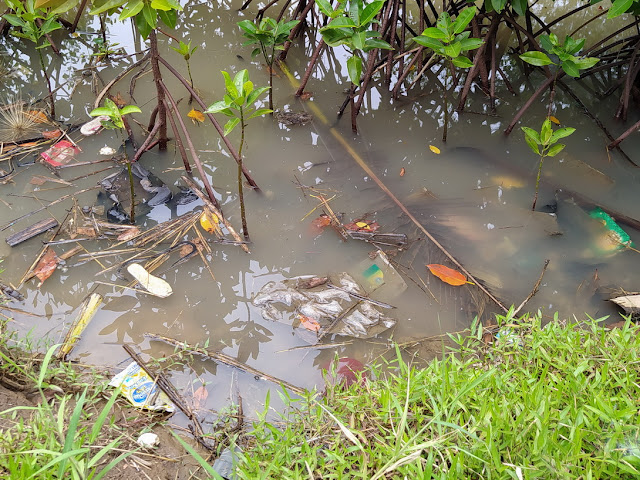Care of Mangroves for Coastal Survival
Sunday, 28 February 2021by Sarlota Wantaar
What is the difference between mangroves and Rhizophora? This is a question that came up among the participants of the exposure of Stube HEMAT Yogyakarta to the Mangrove area in Baros, Tirtohargo, Kretek, Bantul (Sunday, 28/2/2021). It could be that people often say ‘mangrove’ and ‘Rhizophora' but they do not know the difference. This is common because these words often appear, but sometimes not everyone has attention to coastal areas and their problems. The process of building awareness of the existence of coastal areas and their problems has become the concept of exposure or field study carried out by Stube HEMAT Yogyakarta as a chain of the student training on climate change and life survival.
A dozen of students from various campuses and regions such as Lampung, East Nusa Tenggara, Nias, Yogyakarta, and Maluku joined the exposure and had dialogues with the person-in-charge of Baros Youth Family (KP2B) who manage the Mangrove area, Wawan Widia Ardi Susanto. He revealed that KP2B was founded in the 1980s and has youth activities in the village such as youth service, discussion, coconut leaves crafts, and many others. In the discussion activity, they discussed the challenges of young people, how to become independent, and the actual problems including abrasion that erode the coast, salty air that destroys farmers' crops, floods from the Opak river that submerge agricultural land in this area, and garbage carried together with the river flow that pollutes this Baros area.
The mangrove area itself, Wawan explained that conservation activities began to emerge in 2003 when an NGO, Relung collaborated with the residents in Baros to develop a mangrove conservation area. This activity brought up the enthusiasm of the local community, especially KP2B, to follow up with various developments, including eco-tourism, study visits, mangrove planting, bird-watching, and other activities. However, currently, activities have decreased due to the pandemic.
Then, the participants explored the mangrove area and recognized the types of plants in it, including Avicennia, Rhizophora, Nipah, Bruguiera, and Sonneratia with their benefits. Here, it is revealed that mangroves are a group of plants located in the tidal zone that form an ecosystem, while Rhizophora is one of the types of plants found in mangrove areas. One of the benefits of mangroves is the development of sand farming because the salty air that is carried away from the sea can be filtered by the leaves of the mangroves.
The mangrove planting process really enriched the participants' experience. During the planting process, Wawan expressed his anxiety about mangroves' biggest enemy, namely garbage. There is no effective solution to anticipate garbage entering this area. Many efforts were made to protect the new area with bamboo fences and nets to reduce the garbage. This is a hard challenge because most of the rivers in Yogyakarta connect to the Opak river, including the garbage, and the rivers estuary is in Baros. At the end of the activity, the participants observed Baros local youth’s creativity by utilizing wood waste which is created into various artworks, such as Christmas trees, mirrors, fruit bowls, and other decorations for export market.
The participants reflect that the coastal area with green trees is the natural beauty of the beach that will attract everyone, however, how it will be, if the area is damaged due to human negligence, including a changing climate, floods, and garbage. Do humans just stand idle and let the beauty disappear? Humans who are equipped with knowledge will certainly do something to take care of this natural beauty. ***
Web Archive
2024 (22)Total: 465
Youtube Channel
Lebih baik diam dari pada Berbicara Tetapi tidak ada Yang Di pentingkan Dalam Bicaranya
-->








